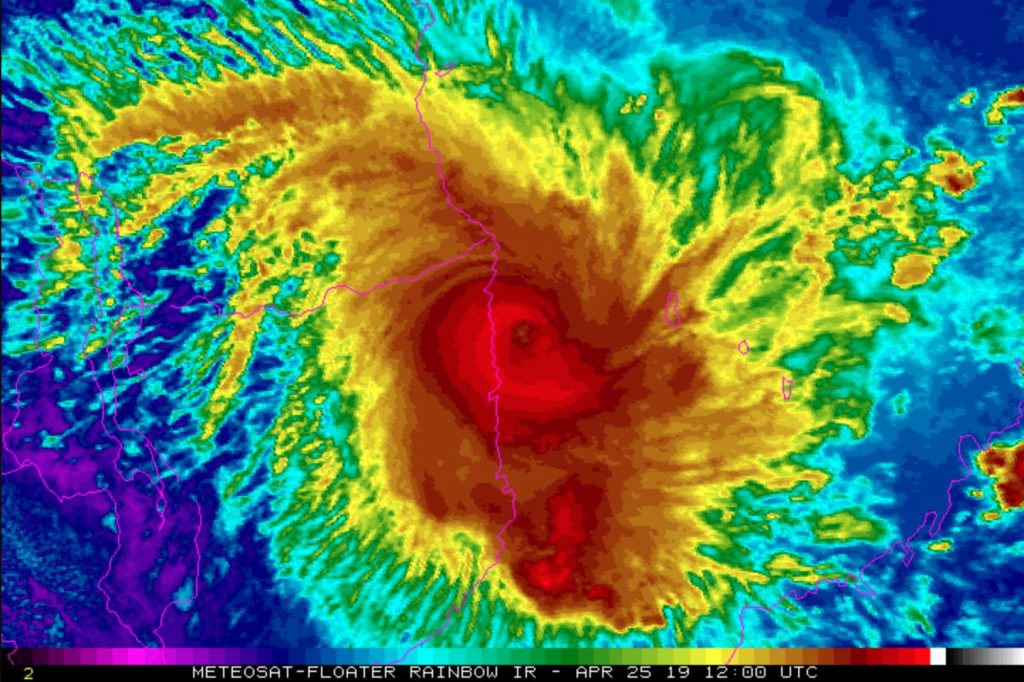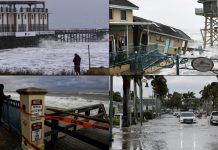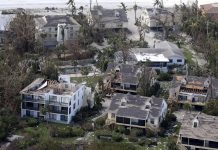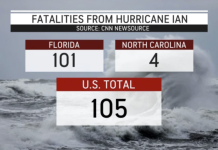The strongest cyclone ever to hit Mozambique has made landfall in the country’s north, five weeks after Cyclone Idai devastated its centre, according to meteorologists. Surpassing both Idai and the 2000 cyclone that had been the strongest to date, Cyclone Kenneth hit Cabo Delgado province with wind speeds of 140mph (225km/h), bringing the threat of extreme rainfall.

Some “precarious” houses had already collapsed and the provincial capital of Pemba has lost its power supply, local journalist Jonas Wazir told AFP.
Forecasters at Meteo-France warned that Kenneth could bring waves as much as five metres (16ft) higher than usual. Anabela Moreira, who owns a lodge on Wimby beach in the port town and provincial capital of Pemba, told AFP: “I’ve never seen anything like it in my 15 years in Pemba.”
Satellite loop showing the final approach of Cyclone #Kenneth before landfall over northern #Mozambique just before local sunset. pic.twitter.com/3efGqTXpiq
— Met Office Storms (@metofficestorms) April 25, 2019
After forming off Madagascar’s coast earlier this week, Kenneth passed to the north of the island nation of Comoros on Wednesday night, killing three people and causing widespread damage to homes and infrastructure.
The storm is expected to stall inland for several days and around one metre of rain is expected in the area north of the city of Pemba, more than the usual average for an entire year in the region. OMG!
Cyclone Kenneth makes its landfall in the Northern part of Mozambique. 3 confirmed dead and 30 000 people evacuated. pic.twitter.com/Nf0DwVleS6
— Themba Nkuna (@Honeyguide15) April 26, 2019
The National Institute of Disaster Management said it would relocate rescue equipment including boats and helicopters from Beira, which was devastated by Idai. Some have been warning that southern Tanzania could be hit too, but the storm path appears to tend south.
Meteorologists said Kenneth was a category 4 hurricane on Wednesday night but had weakened slightly by the time it hit Mozambique. Cyclones of this magnitude are rare in the region, and two within just over a month was unknown until now.
Scenes from Mozambique as Cyclone Kenneth hits.
— Samira Sawlani (@samirasawlani) April 26, 2019
Thousands have been evacuated from their homes after the storm killed 3 people in Comoros.
Mozambique is still recovering from the harrowing impact of Cyclone Idai. pic.twitter.com/YnjRr4G0BJ
“It’s really an anomaly in the history of cyclones in this region. There’s never been two storms this strong hit in the same year, let alone within five weeks of each other in Mozambique,” said Eric Holthaus, a meteorologist who has worked in east Africa and was watching the cyclone’s path closely.
Holthaus said that there was probably a “blocking pattern” in the upper atmosphere that prevented Kenneth from dissipating inland or escaping to the south, so it would most likely sit around 100km inland, attracting more moisture from the Indian Ocean.
Devastating images from #Comoros following #CyloneKenneth.
— IFRC Africa (@IFRCAfrica) April 25, 2019
Homes and roads are damaged and destroyed, telephone poles and trees are down. Red Crescent volunteers are supporting the urgent needs of communities, providing first aid and assessing needs on the ground. pic.twitter.com/Fl0t5C3vh1
“Nothing like this has happened in this region, and rarely happens anywhere in the world, where a cyclone of this strength stalls for this many days. So the kind of rainfall totals that the models are showing for Kenneth are really extreme in the global context,” he said.
There is evidence, however, that blocking patterns such as the one that makes Kenneth so intense are getting stronger with climate change, he added. The rainfall, which could reach 1.5 metres in some areas, will be catastrophic for the people of northern Mozambique.
Tropical Cyclone #Kenneth ?has now intensified to category 4 hurricane strength after passing #Comoros ?? and is heading for north #Mozambique ??landfall in around 16 hours time #CycloneKenneth pic.twitter.com/OdG3CBwSlW
— YouStorm (@YouStormorg) April 25, 2019
“We have very strong evidence that everywhere in the world, rainfall is getting more intense. So that means you can get the same amount of rainfall, but it just happens in a shorter period of time, because if the atmosphere is warmer then that will create more intense thunderstorms that rain out faster,” Hotlhaus said.
“We can directly link Kenneth with climate change for that reason. Not only is this an extremely intense rainfall event, globally, but it’s being made worse because of climate change.“
Just been sent this video from a farmer in Macomia, filmed today. #CycloneKenneth #Mozambique pic.twitter.com/jDOEICxQ0G
— Luke Dray (@LukeDrayPhoto) April 25, 2019
Volunteers from the Red Cross have spent the past few days warning people in the storm’s path and advising them to secure their roofs, put sandbags around their houses and get out of the area if possible.
“Most of these people are living in dire poverty … so it’s not the case that they can just get in the car and drive 200km inland. They really are exposed,” said the Red Cross’s Matthew Carter, who was about to board a plane north from Beira, where aid workers are providing food, water, shelter and medicine to thousands of people made homeless by Idai.
First signs of the arrival of Cyclone Kenneth in northern Mozambique
— Daily Nation (@dailynation) April 26, 2019
Images show the stormy weather along the coastline at Pemba, in northern Mozambique, as the country braces for the arrival of a new cyclone barely a month after a Cyclone Idai devastated the country pic.twitter.com/Q7fZSA8BGg
The tropical cyclone could be accompanied by eight-metre waves and a three-metre storm surge.
The increased threat of diseases like cholera and malaria, as well as the availability of food, are major long-term worries that communities affected by both Kenneth and Idai face. Kenneth has hit at the peak of harvest season, meaning a possible six-month period without food.
“It’s not just the immediate effects of someone losing their home, it’s also the longer term effects of food price increases and lack of a harvest for farmers,“ Carter said.
Storm surge during low tide at 2pm #Pemba #CycloneKenneth pic.twitter.com/kUuDO529Ti
— Phillip (@Phillip68793873) April 25, 2019
The Cabo Delgado region of northern Mozambique is not as highly populated as the area surrounding Beira, and the main coastal city, Pemba, is not expected to take a direct hit, so there may be fewer people directly affected than by Idai. But the country is struggling to deal with the after-effects of the first cyclone and has little capacity to tackle a new disaster.
Mozambique has had to take out a $118m (£91m) loan from the IMF in the wake of Idai, something that debt relief campaigners have called a “shocking indictment” of the international community, saying impoverished countries should be given emergency grants rather than having to borrow more money.
The next mega-catastrophe in Africa!











